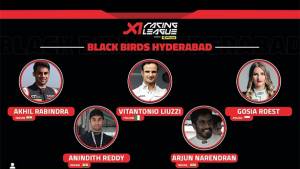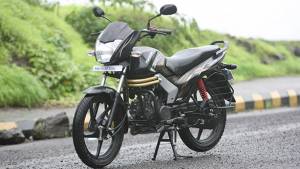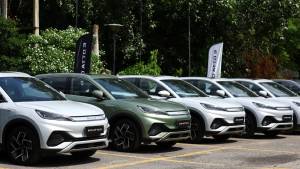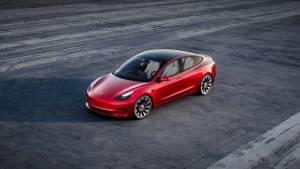Mobile influence to drive purchase of 8 in 10 cars, 7 in 10 two-wheelers by 2022: Zero Friction Future Report by Facebook
The Zero Friction Future (ZFF) programme aims to define, understand and mitigate friction in consumer purchase journeys to unlock business growth with use of mobile in media. Consumers prefer to follow the path of least resistance and avoid anything that makes it challenging for them to move to the next step or make a purchase. The traditional path to purchase has transformed with the advent of technology, smartphones and digital assistants, and is likely to be replaced by personalised journeys.
Any unnecessary additional effort, incremental step or inconvenience which leads consumers to abandon their purchase journey is defined as friction. Consumer pain points that lead to friction can occur across three main stages of the consumer journey: awareness, consideration and intent. Covering all these aspects for the automobile industry, the report titled "Eliminating Friction in Automobile Path to Purchase" is the second in a series of the ZFF reports. The first report was aimed at the smartphone industry.
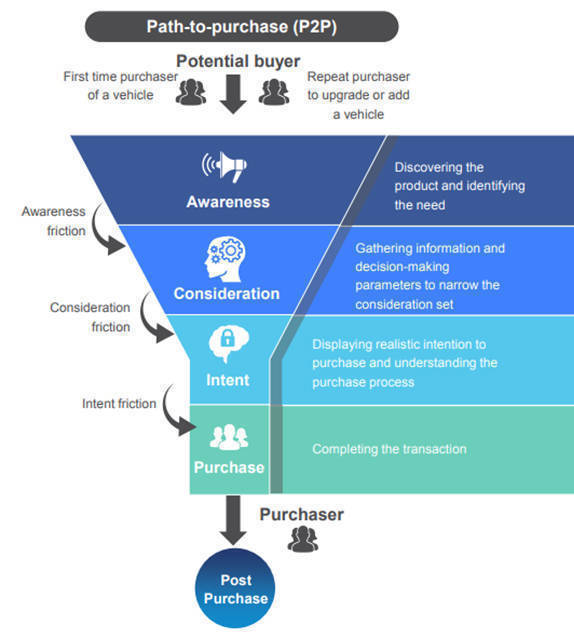
Eliminating Friction in Automobile Path to Purchase identifies the opportunities where mobile intervention could reduce this friction in the automobile industry. The reports are authored by KPMG in India, based on primary research and insights based on the survey conducted by Nielsen for various industry verticals, and commissioned by Facebook.
To understand the peculiarities of the automobile purchase journey and associated friction at its different stages, a survey was conducted by Nielsen India among 3,987 respondents in the automotive category across varied demographic and socio-economic groups. KPMG in India, also interacted with industry experts to obtain their perspective on the possible approaches to reduce friction and improve upon the conversion rates.
Key findings
The report states that India has emerged as one of the world's largest and fastest growing automobile markets over the years, with production of 29 million vehicles in FY18 and an estimated production of about 60 million vehicles by 2022. It is also the leading manufacturer of two-wheelers in the world and a global hub for small cars, contributing approximately 30 per cent of the global small car sales.
Low vehicle penetration (20 vehicles per 1,000 people) and growth of Indian middle class with increasing purchasing power along with strong growth of the Indian economy over the past few years have inspired major OEMs around the globe to turn their attention towards the Indian market. From the survey, it was found:
Four-wheelers:
- Media accounts for at least one-third of the friction in this category. This friction in turn is responsible for 26 per cent of consumer dropouts during the purchase process
- By 2022, 80 per cent of four-wheeler purchases will be influenced by mobile
- Facebook is expected to influence nearly half of all four-wheeler purchases by 2022
- Optimizing Mobile in the media mix can reduce media friction and help brands tap into a potential sales opportunity of 1 million four wheelers by 2022, and also reduce their average cost of consumer acquisition by approximately 14.7%
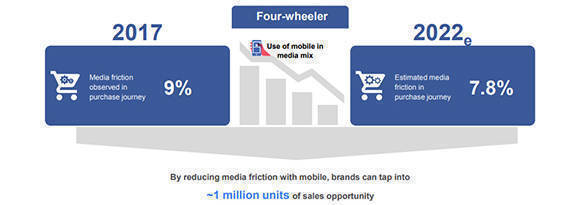
Two-wheelers:
- Purchase friction deters nearly 34 per cent consumers, and media is responsible for almost half of this friction at present
- By 2022, nearly 70 per cent of the two-wheeler purchases will be influenced by media
- 50 per cent of all two-wheeler purchases are expected to be influenced by Facebook
- Optimizing Mobile in the media mix can reduce media friction and help brands tap into a potential sales opportunity of 2.6 million two wheelers by 2022, and also reduce their average cost of consumer acquisition by approximately 7.8%
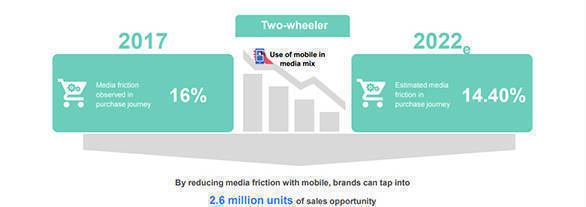
Top friction areas across demographics
According to the research, top friction areas for different demographics vary and hence marketers need to customise their marketing strategy accordingly. Some key consumer friction areas include:
Gender-based:
- Four-wheelers: While a woman customer expects sales assistance, men demand swift response from the brand and dealers.
- Two-wheelers: Men seek technical assistance, while women seek clear communication of offers during a purchase.
Age-specific:
- Four-wheelers: Individuals between 35-49 years of age are most likely to pursue a four-wheeler purchase. However, they are also less tolerant to friction and more likely to drop out of their purchase and hence need attention
- Two-wheelers: Prospective buyers between 25-34 years of age are the most likely to make a successful purchase, with a conversion rate of 50 per cent. But they also seek the most information about the product throughout the journey. The 18-24 and 35-49 age groups rely more on expert advice and also prefer physically testing the product before deciding.
Socio-economic:
- Four-wheelers: An NCCS-A classified person is 10 times more likely to purchase a four-wheeler than an NCCS-B person. Both groups, however, follow a very similar purchase journey seeking the same information.
- Two-wheelers: NCCS-A prospects are over five times as likely to complete two-wheeler purchase as NCCS-B ones. The latter group also values targeted information and response from the brand more than finance support.
Related Stories
Top Stories
Latest Videos
Most Popular
- Budget Sportbike Showdown: Kawasaki Ninja 500 vs Aprilia RS 457 vs Yamaha YZF-R3
- Mumbai-Pune Expressway speed restrictions updated
- 2014 Triumph Daytona 675 vs 2024 Kawasaki ZX6R - A Decade of Evolution in Supersport Motorcycles
- 2024 Hyundai Creta vs Toyota Urban Cruiser Hyryder vs Skoda Kushaq comparison review - the hype is real?
- Nissan Magnite EZ-Shift review - is the AMT any good?
